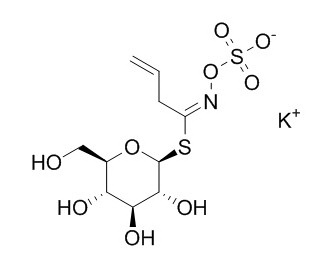Sinigrin
Sinigrin has antimicrobial activity. Sinigrin also exerts important anti-proliferative activities in carcinogen-induced hepatocarcinogenesis in rats.
Inquire / Order:
manager@chemfaces.com
Technical Inquiries:
service@chemfaces.com
Tel:
+86-27-84237783
Fax:
+86-27-84254680
Address:
1 Building, No. 83, CheCheng Rd., Wuhan Economic and Technological Development Zone, Wuhan, Hubei 430056, PRC
Providing storage is as stated on the product vial and the vial is kept tightly sealed, the product can be stored for up to
24 months(2-8C).
Wherever possible, you should prepare and use solutions on the same day. However, if you need to make up stock solutions in advance, we recommend that you store the solution as aliquots in tightly sealed vials at -20C. Generally, these will be useable for up to two weeks. Before use, and prior to opening the vial we recommend that you allow your product to equilibrate to room temperature for at least 1 hour.
Need more advice on solubility, usage and handling? Please email to: service@chemfaces.com
The packaging of the product may have turned upside down during transportation, resulting in the natural compounds adhering to the neck or cap of the vial. take the vial out of its packaging and gently shake to let the compounds fall to the bottom of the vial. for liquid products, centrifuge at 200-500 RPM to gather the liquid at the bottom of the vial. try to avoid loss or contamination during handling.
Appl. Sci.2022, 12(4), 2032.
Foods.2024, 13(11):1739.
Psychopharmacology (Berl).2020, 10.1007
Plant Physiol Biochem.2023, 202:107913.
Biomed Pharmacother.2020, 125:109784.
Industrial Crops and Products2017, 95:286-295
Int J Mol Sci.2020, 21(8):2790.
Asian Journal of Chemistry2014, 26(22):7811-7816
Mol Cells.2018, 41(8):771-780
J Sep Sci.2023, 46(16):e2300160.
Related and Featured Products
Lett Appl Microbiol. 2015 May 15.
Use of a nanoparticulate carboxymethyl cellulose film containing sinigrin as an antimicrobial precursor to kill Escherichia coli O157:H7 on fresh beef.[Pubmed:
25976711]
METHODS AND RESULTS:
Nanocomposite carboxymethyl cellulose films containing Sinigrin (SNG) were prepared by stirring 2% (w/v) carboxymethyl cellulose (CMC) and 2% (w/v) glycerol (as a plasticizer) in distilled water with or without SNG (an antimicrobial precursor) as a 99% pure reagent (pSNG) or as a crude extract (cSNG). These films plus normal CMC film with or without SNG were tested on Escherichia coli O157:H7- inoculated beef for antimicrobial activity. Beef pieces measuring 6 × 5 × 2 cm(3) (L × W × H) were dipped in an E. coli O157:H7 broth suspension containing >8 log10 CFU ml(-1) and were drained for 3 min over a sterile cloth. They were wrapped in CMC or NCMC films, placed in a high oxygen barrier film (Deli *1), vacuum-packaged and stored at 8°C for 5, 8, 12 and 18 days.
CONCLUSIONS:
The CMC and NCMC films without SNG were not antimicrobial against E. coli O157:H7; however, NCMC and CMC films with SNG were highly antimicrobial. After 5 days at 8°C, E. coli O157:H7 was reduced more than 4 log10 by the NCMC•pSNG film and this reduction remained almost the same until 18 days at 8°C when E. coli O157:H7 was reduced >5 log10 CFU g(-1) meat.
PLoS One. 2014 Oct 20;9(10):e110145.
Anti-proliferative activities of sinigrin on carcinogen-induced hepatotoxicity in rats.[Pubmed:
25329483]
Liver cancer is one of the leading causes of cancer death worldwide. A very high incidence of new liver cancer cases is diagnosed every year, and metastasis has been found to correlate to poor prognoses in humans. Better treatments for liver cancer are thus clearly needed. Sinigrin is one of the major ingredients present in Brassica nigra, which has been used in combination with other herbs for treatment of various diseases.
METHODS AND RESULTS:
The anti-proliferative activities of Sinigrin were studied in a model of carcinogen-induced hepatotoxicity in rats. Rats were orally administered with Sinigrin on a daily basis for three months before sacrifice. Sinigrin was found to significantly inhibit the proliferation of liver tumor cells; the number of surface tumors in the rat liver was dramatically reduced. Sinigrin induced apoptosis of liver cancer cells through up-regulation of p53 and down-regulation of Bcl-2 family members and caspases. Our findings indicated that the liver functions were gradually restored after treatment with Sinigrin and that the agent did not cause liver toxicity. Cell cycle analysis indicated that Sinigrin caused cell cycle arrest in G0/G1 phase.
CONCLUSIONS:
The results suggest that Sinigrin exerts important anti-proliferative activities in carcinogen-induced hepatocarcinogenesis in rats, and highlight the potential of Sinigrin as an anti-cancer agent for liver cancer.



